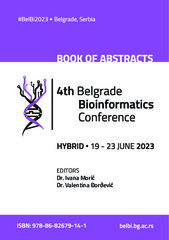Приказ основних података о документу
Impact of different mapping tools on detection of small RNAs in bacterial outer membrane vesicles
| dc.contributor | Morić, Ivana | |
| dc.contributor | Đorđević, Valentina | |
| dc.creator | Banović Đeri, Bojana | |
| dc.creator | Nešić, Sofija | |
| dc.creator | Pantelić, Ana | |
| dc.creator | Samardžić, Jelena | |
| dc.creator | Nikolić, Dragana | |
| dc.date.accessioned | 2023-08-14T08:54:04Z | |
| dc.date.available | 2023-08-14T08:54:04Z | |
| dc.date.issued | 2023 | |
| dc.identifier.isbn | 978-86-82679-14-1 | |
| dc.identifier.uri | https://belbi.bg.ac.rs/ | |
| dc.identifier.uri | https://imagine.imgge.bg.ac.rs/handle/123456789/2030 | |
| dc.description.abstract | Bacterial small RNAs (sRNAs) represent a highly diverse RNA class ranging from 8 to 200 nucleotides in length, originating from the bacterial chromosome, plasmids or phages. After syntheses sRNAs can remain inside the bacterial cell, be secreted or packed into outer membrane vesicles (OMV), enabling various intra- and inter-kingdom interactions. Different sRNAs biotypes display differences in structure, mechanism of action and level of regulation (i.e. transcription, translation, mRNA stability, etc.), but could be broadly grouped in: trans-acting sRNAs (bind to target mRNAs) and cis-encoded sRNAs (or antisense RNA that may interact not only with mRNAs, but also with proteins and DNA). Even though the advancement of high-throughput sequencing technology led to a burst of knowledge on small RNAs complexity and diversity, there are still specific challenges related to sRNA-seq data analysis that need to be resolved. Two main challenges, associated to short length of many bacterial sRNA biotypes, are: (i) to discriminate between functional sRNAs synthesized by bacterial cell and degradation fragments produced by sample preparation and (ii) to detect functional sRNAs displaying sequence variation. While loss of very small sized sRNAs could easily be overcome by cutting-off only the specific adapter sequences that were used in sRNA library preparation, providing a proper mapping still remains a strenuous task. The aim of this study was to test five different mapping tools that are widely used in NGS data analysis (bbmap, bowtie2, bwa, minimap2 and segemehl) for their performances in mapping of bacterial OMV sRNA-seq data to bacterial reference genome. For this test publicly available NCBI sRNA-seq dataset from OMVs of Aliivibrio fischeri (PRJNA629425) was used, as it contained sRNAs of different length and biotype and because A.fischeri reference genome and annotation were available (PRJNA12986). We evaluated five mappers using alignment and assignment rates as well as computational time. Alignment rate was calculated as the ratio of aligned and input reads, while the assignment rate was calculated as the ratio of assigned and aligned reads. Finally, totals of detected sRNAs biotypes were compared between different mappers. The statistical analysis was performed in R (version 4.3.0) and performance metrics are discussed. | sr |
| dc.language.iso | en | sr |
| dc.publisher | Belgrade : Institute of molecular genetics and genetic engineering | sr |
| dc.relation | info:eu-repo/grantAgreement/ScienceFundRS/Ideje/7744906/RS// | sr |
| dc.rights | openAccess | sr |
| dc.source | 4th Belgrade Bioinformatics Conference | sr |
| dc.subject | small RNAs | sr |
| dc.subject | outer membrane vesicles | sr |
| dc.subject | mapping | sr |
| dc.title | Impact of different mapping tools on detection of small RNAs in bacterial outer membrane vesicles | sr |
| dc.type | conferenceObject | sr |
| dc.rights.license | ARR | sr |
| dc.rights.holder | © 2023 Institute of Molecular Genetics and Genetic Engineering, University of Belgrade | sr |
| dc.citation.epage | 85 | |
| dc.citation.spage | 85 | |
| dc.citation.volume | 4 | |
| dc.description.other | Book of abstract: 4th Belgrade Bioinformatics Conference, June 19-23, 2023 | sr |
| dc.identifier.fulltext | https://imagine.imgge.bg.ac.rs/bitstream/id/319738/BELBI-Abstracts-final-07072023_1-15,101,129.pdf | |
| dc.identifier.rcub | https://hdl.handle.net/21.15107/rcub_imagine_2030 | |
| dc.type.version | publishedVersion | sr |

